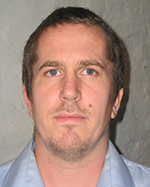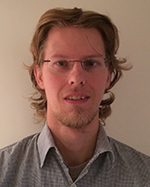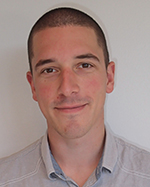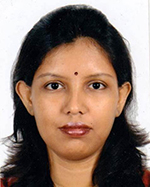Tidligere arrangementer - Side 15
M.Sc. Håvard Gjersdal ved Fysisk institutt vil forsvare sin avhandling for graden ph.d: "Test beam track reconstruction and analysis of ATLAS 3D pixel detectors"
M.Sc. Håvard Gjersdal ved Fysisk institutt avholder prøveforelesning over oppgitt emne: "The Higgs boson: Revealing the Secrets of a Nobel Particle"
M. Sc. Andreas Hafver ved Fysisk institutt vil forsvare sin avhandling for graden ph.d: "Drainage by fracturing: a mechanism for primary migration"
M. Sc. Andreas Hafver ved Fysisk institutt avholder prøveforelesning over oppgitt emne: "Fractals and fractures" .
Jesús Zavala Franco, University of Copenhagen [slides]
Although there is substantial gravitational evidence for the existence of dark matter, its nature as a new particle beyond the Standard Model remains one of the biggest mysteries in modern astrophysics. The favourite theoretical model, Cold Dark Matter (CDM), assumes that non-gravitational dark matter interactions are irrelevant for galaxy formation and evolution.
Surprisingly, there is no strong evidence for the CDM hypothesis. Current astronomical observations allow significant departures that have a relevant impact on our understanding of how galaxies form and evolve. Moreover, the observed properties of the smallest galaxies have been consistently in conflict with the predictions of the CDM model.
In this talk, I will argue that to explain galaxy formation and evolution in the broadest sense, an effective dark matter theory must contain a wider range of dark matter particle physics without spoiling the success of CDM in reproducing the large-scale structure of the Universe, while addressing its outstanding challenges at the scales of individual galaxies.
M. Sc. Reidar Lunde Lillestøl ved Fysisk institutt vil forsvare sin avhandling for graden ph.d: "Collective effects and experimental verification of the CLIC drive beam and decelerator"
M.Sc. Ole Ivar Ulven ved Fysisk institutt vil forsvare sin avhandling for graden ph.d: "Carbonation of ultramafic rock: Mechanochemical aspects"
M. Sc. Reidar Lunde Lillestøl ved Fysisk institutt avholder prøveforelesning over oppgitt emne: "Quantum Entanglement with Applications"
M.Sc. Ole Ivar Ulven ved Fysisk institutt avholder prøveforelesning over oppgitt emne: "Generation, transport and destination of H2O-CO2 fluids in subduction zones at 100 to 500°C"
Ivica Picek, Univ. of Zagreb
After the discovery of the Higgs boson, searching for the dark matter (DM) is one of the main targets for the LHC. In light of evidence for neutrino mass it would be appealing that DM particles account for a solution to the small neutrino mass. A radiative neutrino mass realization dubbed "scotogenic" (with DM particles in a loop) imposes an exactly conserved Z_2 symmetry to eliminate tree-level neutrino masses and to simultaneously stabilize a DM candidate.
In this talk I will discuss the possibility to avoid such ad hoc Z_2 symmetry: either by promoting it to a local gauge U(1)_D symmetry or by requiring that it arises "accidentally" (on account of the SM symmetry and a choice of the field content). In this context, I will discuss the testability of Majorana singlet, triplet and quintet DM candidates at the LHC.
Alejandro Ibarra, Technische Universität München [slides]
The search for the gamma-rays which are presumably produced in dark matter annihilations is hindered by the existence of large, and still poorly understood, astrophysical backgrounds. In this talk we will emphasize the importance of sharp spectral features for the identification of a dark matter signal. We will review the status of the search of the various spectral features that arise in Particle Physics scenarios and we will discuss the interplay with other search strategies.
Master of Science Humayra Ferdous ved Fysisk institutt vil forsvare sin avhandling for graden ph.d: "Study of Changes in Lung Transfer Impedance due to Ventilation Using Focused Impedance Measurement (FIM) Technique"
Master of Science Humayra Ferdous ved Fysisk institutt avholder prøveforelesning over oppgitt emne: "The history of the recording of the Electrocardiograph - ECG/EKG"
Pat Scott , Imperial College London [slides]
Searches for particle physics beyond the Standard Model come in many forms, from searches for new particles at accelerators to gamma-ray and neutrino telescopes, cosmic ray detectors and ultra-clean experiments deep underground. Efforts to combine multiple search channels in 'global fits' to new physics scenarios typically consider only a subset of the available channels, and apply them to a very small range of possible theories. Astroparticle searches in particular are usually only included in a very approximate way, if at all. In this talk I will review recent progress in improving this situation, and preview some of the future developments and challenges in this field.
Michael Kachelriess, NTNU [slides]
The IceCube Collaboration announced 2012 evidence for the first detection of extraterrestrial neutrinos. Meanwhile, the discovery of a extraterrestrial neutrino flux (of surprisingly large magnitude) has been established. After a review of the basic ideas of high-energy neutrino astrophysics, I discuss possible sources for these neutrinos and their signatures. I discuss the neutrino yield from collisions of cosmic ray nuclei with gas and the possibility that Galactic sources can explain the IceCube excess. I review also the cascade bound on extragalactic neutrinos and its consequences.
Jörn Kersten, Universitetet i Bergen [slides]
Despite the astonishing success of the standard LambdaCDM cosmological scenario, there is mounting evidence for a tension with observations. For example, some measurements indicate that a part of the dark matter is hot. In addition, the observed properties of relatively small galaxies do not quite agree with the predictions by simulations of structure formation.
I will discuss a simple particle physics model containing cold dark matter (DM) and sterile neutrinos. Both are charged under a new gauge interaction. The resulting DM self-interactions and DM-neutrino interactions resolve the problems with structure formation. The sterile neutrinos can account for both a small hot DM component and the neutrino anomalies found in short-baseline experiments.
Anders Kvellestad, UiO
Recently a few small (but intriguing) deviations from Standard Model predictions have been identified in the LHC data, one being an excess in the dilepton spectrum in a CMS search for so-called 'kinematic edges' -- a classic signal of physics models with heavy particles decaying through sequential two-body decays. We present an interpretation of this excess in terms of a supersymmetric model with squarks undergoing such sequential decays down to the lightest neutralino, which is a viable candidate for particle dark matter. The good-fit parameter space of the model is presented, along with predictions for squark production at the upcoming 13 TeV LHC run.
Further, using the above analysis as an example, we briefly comment on the main challenges of confronting complex models like Supersymmetry with experimental results, and present an ongoing effort to overcome some of these challenges.
Årets Nobelpris i fysikk annonseres 7. oktober. Vi ser sendingen sammen.
Marius L. Meyer, UiO
In recent years there has been extensive interest in the study of strongly correlated states of cold atoms motivated by analogies with exotic states known from low-dimensional electronic systems, particularly quantum Hall states. In this talk I will present an analysis of the yrast states of two-component rotating Bose gases using Jain's composite fermion (CF) approach. A particularly simple subset of CF states are found to give very good approximations to the lowest energy states for low angular momenta.
CERN er 60 år og Cinemateket viser dokumentarfilmen "Partikkelfeber" på stort lerret.
Ansatte og studenter ved UiO får billetter til medlemspris!
-A new window on our Space environment: The polarization of the auroral emissions. A French – Norwegian discovery.
Har du lurt på hvordan et renrom ser ut? Interessert i nanoteknologi, solenergi eller forskning generelt? Mikro- og nanoteknologilaboratoriet åpner dørene for publikum!







